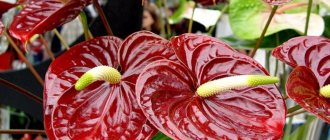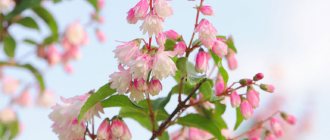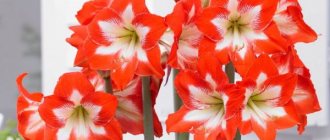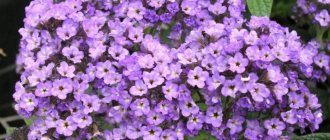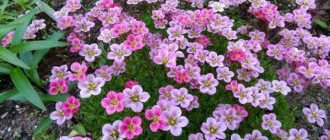In a state of rest
The rest period is 4 months. This is the optimal value for normal development and flowering. In this case, the following care features are observed:
- Amaryllis care at home after flowering does not require much time. You need to choose a place where there is no direct sunlight. At the same time, you should not remove all the leaves so that the beneficial substances from them get into the bulb.
- After the flower has begun to fade, experts recommend waiting for the peduncle to dry and, taking out the bulb, separate the young children from it, treat the existing wounds and remove the dried roots. Then you can plant it again in the same pot or store it in a cool place.
- To protect seed material from pests and diseases, it is treated with a weak solution of potassium permanganate.
- When storing without soil, a preventive inspection is carried out every week to promptly identify lesions or prevent the bulbs from drying out.
Important! Planting material must be large and healthy
How to grow a plant: step-by-step instructions
Amaryllis is a flower that is most often propagated at home by vegetative means, and with proper care it blooms in 2-3 years, retaining all the varietal characteristics of the mother plant.
To do this you need:
- Prepare nutrient soil and sterilize it to kill pests by dousing it with boiling water.
- Place a drainage layer of expanded clay or pebbles on the bottom of the pot, pour the prepared substrate on top.
- Inspect the bulbs, which should be healthy in appearance, not deformed, undamaged, free from stains and mold. Clear them of “clothes” of dark scales.
- Disinfect the “babies” selected for planting for half an hour and place them in a container with soil 2/3 full (the top of the bulbs should be above the soil).
- Compact the soil around the bulb.
Working with an adult onion is done in the same order, but in this case you should pay attention to the container. A bulb already prepared for flowering, throwing out a peduncle with a heavy inflorescence at the top, can overturn the pot.
Therefore, it is necessary to choose a deep and solid container, preferably ceramic, for the stability of the plant and additional supply of oxygen to the roots through the pores of the material.
Amaryllis, what kind of flower, description
This perennial plant belongs to the Amaryllis family. Translated from the ancient Roman language, amaryllis translates as “sparkling”; this name was given to the flower by the famous poet of those times, Virgil. But gardeners prefer to call the plant a March rose for the spring beginning of flowering.
Home decoration
In the wild, amaryllis is found in southern Africa. According to the classification, the genus is a variety of lilies. Carl Linnaeus mistakenly attributed it to Hyperastrum varieties due to the obvious similarity of many morphological characters. Even now, some gardeners confuse these two varieties. But, despite the large peduncles, the latter have no smell.
Planting and replanting amaryllis
Since amaryllis bulbs cannot overwinter even at minimal negative temperatures, it is better to grow the plant in pots. However, in the southern regions of Russia, in the Krasnodar Territory, it is also planted in the ground.
Only in places with warm winters can amaryllis grow in open ground
Choosing a pot
The diameter of the pot for amaryllis should be 4–5 cm larger than the diameter of the bulb itself, that is, when planting, there should be about 2 cm from the bulb to the wall of the pot. The same rule should be followed when transplanting grown plants into a larger pot.
Pots for amaryllis are selected depending on the size and number of bulbs
It is better to take the pots themselves tall, stable, and for group plantings of several bulbs, use large pots. Since the plant produces a large number of children, group planting is preferable.
Soil selection
Amaryllis is undemanding to the soil - any purchased soil with neutral acidity will suit it, but for better air exchange per 10 liters of soil it is better to add 2-3 liters of coconut substrate and 1 liter of vermiculite.
Since amaryllis belladonna is most often sold as bulbs rather than as flowering plants, they are planted in soil or pots.
Landing
- We pour 2-3 cm of drainage into the bottom of the pot; it is best to use modern material - expanded clay.
- Fill the pot with soil so that the top of the bulb peeks out slightly above the level of the walls of the pot.
- We place the bulb and fill it with soil, not reaching the edge of the pot by 1-2 cm for ease of watering.
- Lightly knead the soil around the bulb and spill it with water.
In hot climates with very warm winters, where the temperature does not drop below +10C, amaryllis are planted in the ground so that the entire bulb is immersed in the soil, and then the flower stalks emerge from the bare ground.
Is support needed?
Flowers growing in the ground do not need support. When planting bulbs in pots, especially if the bulb is not completely buried in the ground, sometimes you need to put supports to support the flower stalk. With a lack of light, the leaves can also become frail and fall apart; they can be collected using circular supports.
To prevent leaves and flower stalks from falling, use circular supports
Combination of amaryllis with other plants and use in landscape design
In landscape design, amaryllis can be planted along with other perennial flowers that bloom in early autumn. They will complement the bright autumn fireworks with their riot of colors. Amaryllis will also look good in solo plantings. You can combine several different varieties of amaryllis in one bed.
Some designers advise combining amaryllis with ground cover so that the flower stalks do not appear so bare. It will look great on sunny alpine slides among the stones. By looking at the photo with these flowers, you can easily determine the best place for amaryllis on your site.
Many people believe that amaryllis are best grown in pots, but this is not true. It is growing in open ground that gives amaryllis the brightest shades and richness of color. Although this flower will require some effort on your part during planting and care, this effort will more than pay off when the plant blooms. After all, the time for amaryllis to bloom is autumn: when everything around is covered with a golden carpet, the handsome amaryllis comes to the fore.
Can it be grown in the garden?
To successfully grow amaryllis in the garden, the following rules should be followed:
- Choose a suitable location on the site and planting material. The bulb must be healthy and without any damage, its roots must be well developed.
- Before planting, you need to remove the scales from it and treat it with a disinfectant, this can be a weak solution of potassium permanganate or fungicides. You need to soak the onion for thirty minutes, then leave it to dry for one day. Once the bulb has dried, you can begin planting.
- To grow a flower in open ground, it is recommended to choose a sunny area. This may be located on the south side or in a windless place.
- During flowering, you should pay more attention to the soil and its moisture; if necessary, it is recommended to feed the plant.
- The soil must be fertile and moisture-permeable. If these requirements are not met, it is recommended to treat the selected area with organic mineral fertilizers and loosen the soil.
- The period of planting in open ground is May - June. When planting, you need to take into account the distance between flowers; it should not be less than 10-15 centimeters from each other. To straighten the roots of the flower you need to make spacious and deep holes. After the roots have been straightened, cover the planting material with soil.
- Monitor the plant carefully, as in open ground it can encounter various diseases and pests.
- After the bulb has been planted, water the flower sparingly. When the shoot grows to 10-12 centimeters, water treatments increase; during this period the flower needs more moisture.
If planting rules are followed, amaryllis will bloom in late August or early September.
Description of amaryllis flower
Amaryllis is a member of the Amaryllis family native to South Africa. It is represented by only one species - amaryllis belladonna, but with a large number of varieties and hybrids that differ in shape and color.
Amaryllis: home care
For your information! Very often, amaryllis is confused with its closest relative, hippeastrum. To recognize which flower is growing on the windowsill, it is enough to know the distinctive features of the first one.
Amaryllis has dark green, rather long, narrow leaves (50 cm long and 2.5 cm wide). The fragrant flowers resemble a funnel or a bell; they are collected in umbrella inflorescences of 4-6 pieces. Colors can range from white to red, including purple shades. Amaryllis blooms in the fall, as in its homeland, each flower fades after 6 days. The peduncle is very dense, 50-60 cm long, and is produced along with the leaves. The bulb is pear-shaped and about 5 cm in diameter.
It is very difficult to find an exotic plant in flower shops; hippeastrum is most often sold under the guise of amaryllis.
Therefore, when choosing a flower, you should pay attention to a blooming specimen with a pleasant aroma and a thick peduncle.
Note! In addition to its scientific name, amaryllis has a number of folk names, such as lily, belladonna or naked lady
Amaryllis inflorescences on dense peduncles
History and geography
Amaryllis was brought by botanists and travelers to Europe from South Africa. Its first settlement took place in the botanical gardens of famous persons. The mention of this marvelous flower dates back to 1753. It was discovered in the mayor's garden of Amsterdam, the oldest botanical garden in the world.
He came to the windowsills much later. In the USSR, the peak of its popularity occurred in the 60s of the last century, when people, tired of war, hunger and devastation, began to decorate their homes with strange plants. It was then that amaryllis came to everyone’s rescue, shining with rare beauty and flexible character.
Solving Common Problems
Diseases, pests and violations of maintenance conditions have a negative impact on the appearance of amaryllis, slow down the growing season, and often prevent flowering. Let's look at possible problems and solutions.
Care errors
If the conditions of maintenance are violated, the amaryllis looks faded and unkempt, the foliage withers, the peduncle grows slowly, with a small number of weakened buds.
Blackening of flowers
Cold, excessively humid air leads to darkening of flowers. To solve the problem, reduce watering and raise the air temperature in the room above 18-20 °.
Slow growth
Slow development is caused by a lack of light, moisture, fertilizing, and damage by diseases and pests. Normalization of care and treatment is required depending on the problem.
Bulb rotting
Bulbs rot due to excess moisture, pest damage and fungal diseases. The solution is normalization of watering, treatment with insecticides and fungicides.
Brown spots
Yellow-brown spots are traces of the impact of the false scale insect. Amaryllis is treated with insecticides and folk remedies.
Yellowness of leaves
Excess moisture and aphid infestation can cause yellowing of the foliage. Watering is reduced and the pest is controlled.
Diseases
Most diseases are caused by infection of bulbs and soil by fungi. Excessive watering provokes the development of amaryllis diseases.
Stagonosporosis
Signs of red rot are stripes and spots on the bulb, then on the foliage, orange-red in color. Treatment - bulb extraction, pruning, treatment with fungicides.
Root rot
Signs: deformation, spots on the bulb, wilting of the green part. Treatment - pruning to healthy tissue, treatment with fungicides.
Fusarium
The scientific name for root rot. The disease is caused by fungi of the genus Fusarium.
Pests
Bulb pests are especially dangerous for amaryllis. The infection remains undetected for a long time, during which time the damage often becomes irreversible.
Onion mite
The pest eats the bulbs. It is usually discovered when the green part begins to fade. It is difficult to fight the mite; the plant usually dies.
False shield
Brown seals and spots on the foliage are traces of the false scale insect. Treating with a soap solution, Actellik, Aktara will help you cope with the pest.
Aphid
Weakened, yellowed leaves are a consequence of aphid infestation. Pests are removed manually using insecticides or folk remedies.
Mealybug
A white cottony coating on greens is a sign of mealybug infestation. The foliage becomes sticky and deformed. Physical removal and insecticides help.
Thrips
Stripes, spots, and holes on the foliage are left on amaryllis by thrips. This is a common type of pest that is combated by double application of insecticides - Actellica, Karate, Intavira.
Spider mite
When air humidity is low, spider mites quickly multiply on amaryllis, which can be seen by the thin mesh under the leaves. Treatment – insecticides, increasing air humidity.
Amaryllis mealybug
The white pest hides in onion scales, eating tissue. It is necessary to remove the bulb, excise the damage, and treat it with medications.
springtail
The white insect can be found on the soil. Destruction will require replacing the top layer of soil, treating with insecticides, and limiting watering.
Benefits and harms
The flower simultaneously has both beneficial and harmful properties.
The plant brings the following benefits:
- aesthetic enjoyment;
- absorption of carbon dioxide and release of oxygen;
- attracts dust (good dust collector);
- combating dry indoor air.
Important! Only the Amaryllis bulbs themselves are harmful to humans and animals - they are poisonous.
To protect yourself, it is better to wear gloves when replanting and keep the flower away from children.
Reproduction methods
Amaryllis is easy to propagate. Use 2 methods.
Seeds
Flowering with this method of propagation can be expected only after 5 years. During flowering, use a brush to pollinate the plant (transfer pollen from the stamen to the pistil of another inflorescence). The ripeness of the seed pods is indicated by their opening.
Seeds remain viable for 1.5 months. Sow them to a depth of 0.5 cm in a moist substrate. Keep it at a temperature of +22-25 degrees. When several leaves appear, the plant is planted in individual pots. During the first years of propagation from seeds, amaryllis should remain with leaves. It should be borne in mind that when propagating from seeds, there is no 100% guarantee that all varietal characteristics of amaryllis will be preserved.
By cuttings or dividing the bulb
A more reliable and faster method of reproduction. Babies are formed in healthy bulbs. Sometimes they release leaves right away. It is better to separate them and, without waiting for the flower to be transplanted, transplant them into separate pots. As the amaryllis grows, the container for the children needs to be increased.
Diseases, pests and treatment methods for amaryllis
There are a number of diseases that weaken the flower and spoil its appearance. The most common among them are:
- Anthracnose. This fungal disease is characterized by the appearance of brown spots and streaks on the leaves and their tips. Most often, the cause of anthracnose is excessive watering of the soil and spraying of the flower. In order to cure a flower, reduce watering, remove damaged leaves and treat the plant with a fungicide.
- Stagonosporosis (red burn). The disease develops with excessive watering, as well as frequent and sudden changes in temperature in the room. The disease is characterized by red spots that appear on the entire surface of the plant, including on the bulb.
If they are detected, it is necessary to immediately isolate the flower to prevent infection of other flowers. To cure the plant, it is necessary to cut off the damaged parts of the surface of the bulb and rotten roots and treat them with a fungicide. For the first time after treatment, watering should be limited.
- Gray rot. The most common cause of its appearance is excess moisture in the soil. This infectious disease manifests itself in brown spots on the leaves of the plant. Isolate the flower and then replant it in fresh soil. Water the flower less often, avoiding liquid stagnation in the ground.
- Root rot. Appears due to lack of nutrients and severe temperature changes. Disinfect the soil with Fundazol and isolate the flower for a while, since the infectious agent can persist in the bulb for a long time.
The main pests that interfere with the full development of amaryllis are onion mites, false scale insects, aphids, mealybugs and thrips. To get rid of pests you need to do the following:
- if you notice that the above-ground part of the soil is rotting, reduce the temperature in the room, as it can provoke the appearance of onion mites;
- if brown spots appear on the leaves due to false scale insects, a solution of laundry soap will help, which should be used to treat the affected plant;
- if the leaves turn yellow due to aphids and thrips, treat the plant with a soap solution or Aktara;
- Wet wiping will help against mealybugs, and in more advanced cases, insecticides.
It will also be interesting: Lily tree - planting and care, varieties, names and descriptions?
Why does the plant dry out and the leaves turn yellow?
In addition to diseases and pests, poor care can be detrimental to a flower:
- the roots and lower part of the bulb rot from excessive watering;
- leaves and flowers lose their brightness and attractiveness, become discolored due to oxygen starvation - the plant needs a larger pot;
- leaves and flowers become limp due to prolonged exposure to the sun and drying out roots;
- yellow leaves indicate a flower disease;
- darkened, withering flowers become due to lack of light.
Modern varieties
The development of modern amaryllis breeding proceeds mainly in 3 directions:
- improvement or search for new varieties with classic large flowers of double and non-double forms. I would like to mention such double varieties as Celica, Double Roma, Double Dragon, Ice Queen, Pink Nymph, Merry Christmas, Macarena, Promise, etc. Among the non-double monochrome forms, the varieties Black Pearl, Ampulo, Benfica, Exotica, Faro, are very interesting to my taste. Lemon Lime, Moonlight, Matterhorn, Rosalie, White Baby, etc.;
- searching for fundamentally new two- or multi-color colors, or adding new shades to existing ones. I would note such modern varieties as Charisma, Gervesa, Temptatia, Prelude, Misty, Clown, Neon, Estella, Santa Cruz, Papillio, Pizazz, etc.;
- search for new flower forms, for example, the so-called narrow-petalled varieties of amaryllis or “spiders”, from the English “spider” - spider. This group includes varieties Spotty, Santana, Grandeur, Night Star, Chico, Lima, Evergreen, La Paz, etc. All of them look very beautiful in group compositions, but single flowers, in my opinion, are much inferior to large-flowered hybrids.
Types and varieties for growing at home
For a very long time, only Amaryllis belladonna was considered the only species of amaryllis. This is a plant with large pink flowers up to 18 cm in diameter. The peduncle consists of 3-8 flowers. The leaves have a linear-lingual shape, dense, green, 30-50 cm long. They are arranged in 2 rows.
But in the late 90s, a related crop was discovered in the mountains of Africa, which was named Amaryllis paradisicola. It has wider leaves and a large number of flowers in the inflorescence. The flowers themselves are uniformly pink in color.
After Amaryllis belladonna was cultivated and brought to Europe, it began to be crossed with crinum and brunsvigia. As a result of breeding work, it was possible to obtain hybrids with different flower colors.
Famous varieties of Amaryllis:
- Benfica;
- Dancing Queen;
- Aphrodite;
- Celica;
- Double.
Growing from seeds
Growing a flower using seeds is considered a complex and time-consuming process that does not give a guaranteed result. When planting, you should take into account all the subtleties or the seeds simply will not germinate. To grow amaryllis from seeds you need to do a lot of work and choose the right equipment.
The growing process can be divided into the following stages:
Preparation for planting the selected seeds, this method begins with the transfer of pollen from one flower to the stigma of another. This can be done using a soft brush. To make the result more effective, the flower should be pollinated twice. Within three weeks after pollination, a seed box appears on the flower, containing about 40-70 seeds. The seeds are considered ripe when small cracks appear on the capsule. The seeds are small in size and have a dark colored skin.
Before planting the seed, carefully remove the peel and plant the seed inside.
Preparing the soil and pot: A medium-sized pot should be chosen so that the seeds are not too close to each other during growth. The composition of the soil for rapid germination should include: leaf soil and humus
The seed should be planted in a prepared place to a depth of 0.5 centimeters and sprinkled with soil. To quickly germinate seeds, it is recommended to adhere to the main rule: you need to maintain the air temperature from +21 to +24 degrees Celsius and maintain soil moisture. If all planting conditions are met, the seed will germinate in within one month.
It is important to know how to plant seeds in a pot correctly. The soil needs to be watered a little before planting. Then the container with the seeds is covered with plastic film to create a greenhouse effect and placed in a dark place where the temperature will not be lower than +23 degrees. After a month, the first shoots should appear. They can be replanted into separate pots only when 2 leaves grow on the sprouts. This will happen in 2.5–3 months. Keep in mind that amaryllis grown from seeds will take 5 to 8 years to bloom.
Reproduction methods
Bulbous perennials are bred using generative and vegetative methods. However, the first does not allow maintaining varietal qualities. The second disadvantage of seed propagation is labor intensity and duration: you have to wait at least 5 years for flowering. This method is mainly used for breeding new hybrids. In indoor floriculture, preference is given to vegetative methods for their high productivity.
Seeds
The only important advantage of the method is that the bulb will last much longer and will produce flower stalks regularly. To grow a flower from seeds, you will need fresh planting material.
It is collected from boxes formed on the shoot after artificial pollination. The seeds do not germinate for long: only about a month. They do not need to be dried, because... this also negatively affects germination.
Sequencing:
- The seeds are distributed over the surface of the moistened soil and sprinkled with a 0.5 cm layer of soil.
- The container is kept at a temperature of 22-25°C under glass until germination.
- After the seedlings have formed 1 pair of true leaves, the seedlings are planted in separate pots.
Bulbs
The most popular technique. Order of steps:
- Select a large onion, remove the scales, and divide into 4 parts.
- The cuttings are immersed in a fungicide solution for disinfection.
- After half an hour, the parts are buried ⅓ into a special substrate and kept at a temperature of 22°C until rooting.
Children
When the time comes to transplant a flower, you can get a new specimen by separating the children:
- An onion with roots is cut off from the mother specimen with a sharp, disinfected knife.
- The sections are treated with an antiseptic in the form of crushed activated carbon or a fungicidal mixture.
- The baby is planted in a separate container filled with pre-prepared nutrient soil mixture.
- Move to a warm place to form a root system.
Wintering
At the end of August - beginning of September, they stop feeding the flower and reduce the frequency of watering. At the end of October - beginning of November, watering is excluded. From this moment the leaves begin to fall, and by the end of the season the stems are completely bare.
It is not recommended to artificially remove the leaves, since during the process of dying, all the organic substances contained in them are transferred to the bulb. Thanks to this, the nutritional reserve necessary for future flowering is created. If 2-3 leaves remain for a long time, they can be carefully cut off at the base of the bulb or bent down.
During the dormant period, amaryllis in open ground should be watered once every 15-20 days. Containers with bulbs are stored in a cool, dry (5-12 degrees) place (pantry, greenhouse, garage, winter garden). The flower does not require lighting when at rest. The bulbs are left in this form for 8-9 weeks.
Important! Planting material does not tolerate low temperatures. Even a short-term cold spell can negatively affect the condition of the bulbs
Preparations for wintering
Bloom
Amaryllis, unlike hippeastrum, which blooms in spring, blooms in late summer or early autumn. Its inflorescences can have different colors, often presented in different shades. Flowering duration is up to 2 months.
Attention! Keep in mind that bulbs older than 15 years cannot bloom.
Care after flowering
After flowering has completed, the plant enters a dormant period. Proper preparation for this important period will help extend the life of the plant for many years. Please note that you must first cut off the peduncle and all the leaves from the bulb. Place the underground part in a cool room for 2-3 months. You need to end wintering after a flower shoot or a young leaf appears from the bulb.
Care errors
If you take care of the plant, it will have a bright and attractive appearance. But there are common mistakes that can be avoided:
- If the flowers are very pale, it means that the pot is exposed to direct sunlight. We need to find a darker place.
- In a damp and cold room, the opposite reaction occurs: the flowers darken, and sometimes can even turn black.
- Insufficient watering causes the flowers to droop and the leaves to become pale.
- When damaged by thrips or other pests, the leaves turn yellow.
Bulbous plants are distinguished by gorgeous flowering. But if their care is not entirely good, the plant becomes capricious and does not bloom.
Reasons for this condition:
- There was no dormant period for the bulb.
- There wasn't enough sunlight.
- Low room temperature.
- The soil is not fertilized enough.
- The bulb is damaged by pests.
If there are small children in the house, you need to remember that amaryllis is not only an exquisite flower, but also a poisonous plant. Its bulbs contain poison that African natives used in arrows. A tip soaked in such juice could lead to the death of a person.
Small doses of poison are, of course, not lethal, but as a precaution when transplanting and working with the bulb, it is better to use gloves and not allow children to participate in this process
Amaryllis Aphrodite will decorate any interior
Recently, interest in tropical plants has increased. After all, they give the interior of the house originality and special sophistication. Amaryllis can be considered just such a representative of the flora. How to care for it so that it blooms and no one remains indifferent to the bright buds - the main thing is that everything must be done with love, and the result will not be long in coming.
Optimal conditions for growing a flower
Suitable conditions for growing amaryllis at home differ markedly depending on whether the plant is in an active growth phase or has entered a dormant period.
Suitable conditions for the plant depending on the phase of development - table
| Conditions | Growth phase | Rest period |
| Pot location | Window facing southwest or southeast. A south window will also work, but you will have to cover the plant from direct sunlight during the day so that the leaves do not turn pale or fade. | A dark and cool place with a constant temperature and good ventilation. |
| Lighting | Ideally, bright but diffused light is needed for 14–16 hours a day. The leaves and especially the peduncle tend to reach towards the sun, so periodically they will have to be returned to a vertical position by turning the pot. Or you can make supports for the plant. | Not required. |
| Humidity | The plant is moisture-loving. For irrigation, use room temperature water that has stood for 6–8 hours. The soil should not dry out, but you should not over-water the flower either. It requires more water only during the flowering period. Stagnation of moisture leads to the leaves withering and losing color, and the roots rotting. Spraying the leaves has virtually no effect on the flower. But before flowering, you can slightly moisten the buds. Maintain air humidity at 60–80%. | Watering is completely eliminated. Only soil spraying is carried out. Watering begins again only when the new peduncle grows to 10–12 cm. The optimal humidity in the storage area is 60–70%, without sudden changes. |
| Ventilation | The room should be well ventilated, but avoid strong drafts. | |
| Temperature | Approximately 22–24ºС during the day and about 18ºС at night. The plant does not like sudden temperature changes. | Constant temperature 10–12ºС. |
Conditions for keeping the plant at home
Amaryllis is a flower that requires attention and some skills from the gardener to care for at home. The plant has two phases of life: dormancy and vegetation, and therefore the conditions for keeping it during these periods must be different.
Lighting
A flower born in sunny Africa loves bright light during the active period and prefers the south, southwest, southeast side of the house. However, during the hottest period it must be slightly shaded to avoid burns.
To ensure the health of the plant, its daylight hours must last at least 14 hours. And in order for the tall peduncle to grow straight, without bending to the side, risking breaking off under the weight of the inflorescence, the pot should be periodically rotated around its axis.
A plant that has gone into a dormant period and dropped its stem and leaves is put away in a low-light place: in some apartments the pot is placed in a pantry or bathroom, in houses - in the basement.
Temperature
During the growing season, Amaryllis prefers a fairly high and constant ambient temperature (22-250C); a nighttime decrease of approximately 5 degrees is allowed.
On vacation, the room temperature should be between 10 and 13 degrees. These conditions will allow the plant to gain strength for new flowering without stress. However, it should be remembered that a further decrease in temperature will destroy the flower.
Humidity
Regarding air humidity, there is a simple relationship: the higher the air temperature, the more effort should be made to increase the humidity in the room. In hot weather, the flower should not only be watered, but also sprayed regularly.
To create a comfortable environment, you can place an electric humidifier, a vessel with water or an aquarium next to the plant.
Amaryllis, like almost all indoor plants, does not like drafts, but responds well to airing the room.
Soil and drainage
When purchasing land, you should choose soil designed for the bulbous plant family. When creating a substrate yourself, you need to mix equal parts of turf and garden soil, coarse sand, peat and humus.
The pot for Amaryllis should have holes to drain excess water. A drainage layer of up to 4 cm must be placed at the bottom of the container. This can be expanded clay purchased in a store, small pebbles or coarse sand.
Watering
The South African flower needs watering, but does not tolerate excess water. It should be watered during the growing season only when the earthen coma is dry (but not dry). The soil in the pot just needs to be moistened by directing the spout of the watering can around the perimeter of the pot, without getting on the bulb.
Excess water should be poured out of the pan to avoid rotting of the root system. It is even better to water through a tray.
At the end of the active phase, when flowers and leaves wither, the amount of watering is reduced to twice a week. During the dormant period, the flower is not watered at all or, if necessary, this is done during inspection once every 2 months. Regular watering is resumed in the summer, when the bulb shoot reaches approximately 10 cm.
When can amaryllis be removed?
Amaryllis are highly valued precisely because their flowering time, by properly regulating the dormant period, can be timed to coincide with almost any desired date. But it is still better to do this from December to April for two reasons. These terms are more natural for this plant. In this case, the bulbs are less depleted and better tolerate this event, which, simply put, occurs for them with the least loss. In this case, your collection will bloom beautifully and almost continuously every year, and the bulbs will recover normally in the spring and summer. In industrial conditions, forcing for cutting is carried out almost year-round.
Reproduction, planting and replanting of amaryllis flowers
There are several ways to propagate amaryllis. Among them:
- Vegetative propagation (includes dividing the bulb and separating the children).
- Propagation by seeds.
The first method will require some skill
For propagation, it is important to choose a strong bulb. Without digging it out of the ground, cut off its top - the neck and leaves
Then the onion needs to be cut into four equal parts with a vertical cut.
Amaryllis propagation
However, depending on the size of the bulb, the number of parts can be up to eight. It is necessary to insert knitting needles between the lobes, and treat the cut areas with crushed activated carbon. Subsequent maintenance conditions should include watering as the top layer of soil dries, diffused light and a temperature of up to 28˚C.
Amaryllis can be propagated by seeds after collecting them. When the seed capsule begins to crack, up to 80 seeds can be removed from it. There is no need to dry the seeds after collecting, because this can greatly affect their germination. Sow the seeds in a moist soil mixture and maintain regular watering. For successful seed germination, the air temperature must be at least 25˚C.
When the seedlings form two leaves, they can be transplanted into separate containers.
To plant the bulbs, you need to prepare a pot, gardening tools and warm, settled water for watering. The pot must be larger than the diameter of the bulb in order for the plant to take root well. When choosing soil for a bulb, you should give preference to light and nutritious soil. You need to fill the pot with soil, make a hole in it and place the onion there, leaving its top on the surface.
The soil around the bulb must be moistened and watering continued as the soil dries.
As for replanting, amaryllis can be replanted either annually to encourage lush flowering or every few years. Replanting may be necessary if there are a large number of children or if there is no flowering for a long time. Following these rules will help you replant the plant carefully:
- The flowerpot should be spacious, but the distance between its edges and the bulb should not be more than 3 cm.
- The top of the bulb should not be covered with soil.
- The composition of the soil should include: turf and leaf soil, sand and humus.
- Before transplanting, sterilize the soil.
Diseases and pests
With proper care and a sufficiently long dormant period, amaryllis rarely suffers from diseases and pests. But if this does happen, you need to be able to recognize the symptoms in time and deal with the problem.
Diseases and pests of amaryllis - table
Disease or pest Symptoms Treatment Red burn (stagonosporosis) Small red spots on the bulb or a border of the same color along the upper edge of the scales. Keep the bulb for 1.5–2 hours in a strong solution of potassium permanganate. Grease the largest stains with brilliant green. After 5–7 days you can plant again.Rot and moldRed-gray spots on the surface of the bulb. It becomes soft to the touch and emits an unpleasant sweetish odor. Reddish-brown spots and stripes appear on the leaves. Cut off the affected leaves at the base. Spray the bulb with a 0.05% solution of Bordeaux mixture (5 ml per liter of water) or with HOM and Fundazol, diluted according to the manufacturer's instructions. Spider miteThe leaves seem to be covered with a cobweb. Then they wither and dry. Spray with acaricides such as Oberon, Floromite, Kleschevit, Neoron, Nisoran. Onion mite Eats bulb tissue. The plant develops poorly and practically does not bloom. If flowers appear, they are deformed. The leaves turn yellow and quickly die. Remove the bulbs from the pot and immerse them in water heated to a temperature of 35–40ºC for 5–7 minutes. Then treat with Keltan and Rogor. A radical option is to place the onion in a hermetically sealed container and set fire to a tiny piece of sulfur in it. Wait 2 hours, open the container. Leave the bulb in the fresh air for a day. Thrips Tiny brown dots on the leaves in large numbers. Collect all visible pests, wash the plant, replant in a disinfected pot with sterilized soil. Treat with Agravertin, Fitoverm. MealybugDeposits on the leaves and at the roots, resembling small pellets of cotton wool, as well as a continuous layer of fluff glued with whitish mucus under the leaves. Wipe the leaves with a sponge moistened with clean water. If this does not help, use insecticides (Admiral, Aktara, Aktellik, Iskra, Komandor, Fitoverm). Amaryllis bug Its feces appear under the scales, damaging the bulb. They resemble soot. Use the above insecticides. Scale insects Dense scales on the inside of the leaves. Color varies from light beige to chocolate brown. Next to them is a sticky discharge, similar to sugar syrup. Wipe the leaves with foam obtained from washing-up soap shavings beaten in warm water. Aphids The leaves turn yellow. Collect visible pests by hand. Wipe the leaves with foam of green potassium soap or 20% ethyl alcohol. Springtail Small translucent worms are visible on the surface of the soil. Reduce watering. Remove a layer of soil 3–4 cm thick and replace it with a new one.
The most common pests and disease symptoms - photo gallery
This is how rot appears on leaves
Bulbs affected by stagnospora
Onion mites are extremely difficult to detect until significant damage has been caused to the bulb.
Mealybug is one of the most common pests
Springtails are quite easy to see, but difficult to get rid of.
Spider mite weaves leaves
Planting amaryllis in the ground
At the end of spring - at the beginning of summer, amaryllis is planted in the ground, where the bulb will gain strength and grow to produce a larger flower arrow and ensure more luxuriant flowering of the amaryllis. In addition, hippeastrums and amaryllis planted in the ground bloom longer than their potted counterparts, their bulbs are more actively grown by children, which will give you the opportunity to propagate amaryllis in the fall.
The place for planting amaryllis should be sunny. The soil on the site must be prepared for planting bulbs - enriched with humus and improved by applying organic fertilizers
It is very important that there is no stagnation of water, so a low-lying area is not suitable for amaryllis. It will be best if you place flower beds with amaryllis on a hill
Planting amaryllis is carried out according to the following scheme: the bulbs are planted at a distance of 30 cm from each other to a depth of about 15 cm. In this case, the hole should be of such depth that the long roots of the amaryllis can be freely located.
After planting in open ground, do not water the amaryllis too often for some time, otherwise the flower will devote all its energy to growing foliage, while the bulb needs Spartan conditions to form a flower bud - a certain moisture deficit. But there is no need to limit the plant in water too much. It is interesting that amaryllis, as a rule, bloom on a leafless stem, and the green mass begins to fade even before the peduncle is forced out.
When the flower shoot reaches a height of 5-10 cm, the amaryllis begins to be watered more abundantly. In this case, you need to ensure that there is no stagnation of water and rotting of the bulb. At the same time, you need to tie the arrows to a special ladder for flowers or to another support.
Problems when growing amaryllis
Easy to care for, amaryllis can sometimes cause some difficulties:
| Problem | Elimination methods |
| Stunting | Check the condition of the bulb. Lack of development within 30 days after planting indicates its non-viability. |
| No flowering | Summer vacation, landing in a sunny place. |
| Premature wilting of leaves | Application of fertilizers. |
